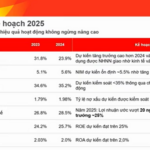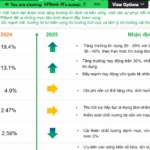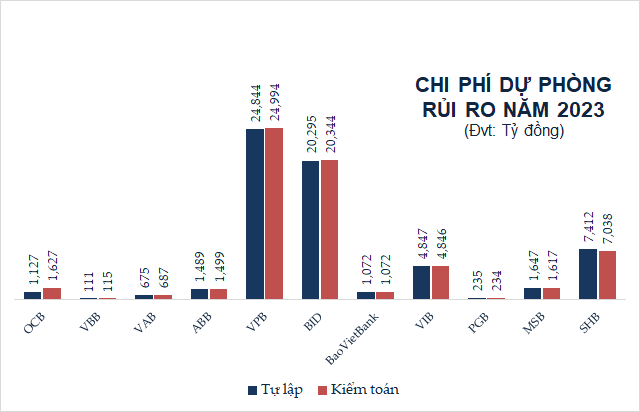**Credit Growth in Vietnam: A Boost for the Economy**
As of March 12, the entire credit growth reached 1.24%
On March 21, 2025, in Haiphong, the State Bank of Vietnam (SBV) organized a conference on “Promoting bank credit to contribute to the economic growth of Region 6.”
At the conference, SBV Deputy Governor Pham Thanh Ha informed that credit growth reached 1.24% as of March 12 compared to the end of 2024 (in February 2024, it decreased by 0.74%).
“According to the norm, credit at the beginning of the year usually decreases, but in early 2025, credit growth showed signs of improvement compared to the same period last year,” said the Deputy Governor.

SBV Deputy Governor Pham Thanh Ha attended and chaired the conference. (Source: SBV)
SBV Deputy Governor Pham Thanh Ha emphasized that 2025 is a particularly important year, marking a pivotal moment for the country to enter a new era of prosperity and civilization. Therefore, a breakthrough in growth is necessary to reach the set goals.
For the banking industry, closely following the solutions and tasks of the National Assembly and the Government, the SBV has concretized the targets and solutions for the entire system regarding monetary policy, credit growth, restructuring, bad debt handling, inspection, supervision, administrative procedure reform, promoting cashless payments, digital transformation in banking activities, and ensuring security and safety in payment activities.
Regarding credit activities, to facilitate credit institutions, the SBV announced and assigned a credit growth target of approximately 16% for 2025 at the end of 2024. This allows credit institutions to proactively meet the capital needs of individuals, businesses, and the economy. Additionally, in the first two months of 2025, the SBV issued ten documents directing credit institutions to vigorously implement solutions for accurate and timely credit growth from the beginning of the year.
They were also instructed to review and simplify loan approval processes and procedures and optimize the application of digital transformation in the credit approval process to facilitate access to bank credit. Credit institutions were instructed to strictly follow the Government and Prime Minister’s directions to stabilize deposit interest rates, contributing to stabilizing the monetary market and striving to reduce lending rates.
To promptly grasp the credit situation and banking activities in the region, the SBV Vietnam has developed a program for the SBV’s leadership team to work in 15 regions nationwide. Region 6 (Haiphong, Hai Duong, Hung Yen, Quang Ninh, and Thai Binh) is the first destination for the Red River Delta region under this program.
According to the Deputy Governor, Region 6 is part of the key economic region in the North, the development nucleus, and the driving force of the Red River Delta region, contributing 11.28% to the country’s GDP in 2024. This region can be said to consist of provinces with strong economic development, a well-invested, synchronized, and modern transport system with many expressways, airports, and seaports. It also houses large-scale industrial parks and has great potential for tourism development. Therefore, promoting credit in Region 6 is of great importance.
Region 6’s outstanding loan balance reached VND 841,342 billion by the end of January
At the conference, Ms. Nguyen Thi Dung, Acting Director of SBV Region 6, reported that the total outstanding loans to economic components reached VND 841,342 billion as of January 31, 2025, accounting for 5.8% of the country’s total outstanding loans. This figure increased by VND 8,159 billion compared to December 31, 2024, equivalent to a 0.97% increase. Haiphong and Quang Ninh had the largest credit balances (VND 261 trillion and VND 202 trillion, respectively), accounting for nearly 60% of Region 6’s total.
By economic sector, as of January 31, 2025, credit to the agriculture, forestry, and fisheries sector reached VND 53 trillion, up 4.1% compared to the end of 2024, accounting for 6.2%. Credit to the industry and construction sector reached over VND 208 trillion, up 3.3% compared to the end of 2024, accounting for 24.7% of the region’s total outstanding loans.
Credit to priority areas as of January 31, 2025, also achieved positive results. Specifically, loans for agricultural and rural development reached VND 226 trillion, accounting for 26.9% of Region 6’s total credit balance. Loans to small and medium-sized enterprises reached VND 152 trillion, accounting for 18.1% of the region’s total credit balance. Meanwhile, credit in potential risk areas remained well controlled.
Concluding the conference, Deputy Governor Pham Thanh Ha stated that Region 6 has about 256 legal entities of credit institutions, with outstanding loans ranking fourth out of 15 regions. This region comprises provinces with significant potential and strength in socio-economic development. Therefore, credit activities in Region 6 are considered to have more advantages than other regions. In the coming time, credit activities in Region 6 will continue to be promoted to contribute to the economic growth goals of the localities.
The Deputy Governor requested the SBV branch to perform well its state management functions regarding currency, credit, and banking activities in the region according to the tasks assigned by the SBV Governor. This includes continuing to direct the branches of credit institutions in the region to provide loans for production and business activities, priority areas, and economic growth drivers as directed by the Government and the Prime Minister.
It is crucial to tightly control credit in potential risk areas, actively participate in and effectively implement the program to connect banks and enterprises in suitable forms, and coordinate with departments and branches to promote the program to connect banks and enterprises. This helps grasp and proactively handle the proposals related to banking activities, and in case it exceeds the authority, report to the SBV, the Provincial People’s Committee for consideration and handling according to regulations.
In addition, the Deputy Governor also requested credit institutions’ head offices and branches in the region to continue reducing operating costs, promoting the application of information technology, and simplifying procedures to reduce lending rates. They should be ready to share a part of their profits to support individuals and businesses.
Implementing solutions for accurate and timely credit growth from the beginning of the year to meet the capital needs of the economy, directing credit to production and business activities, priority areas, and economic growth drivers, tightly controlling credit in potential risk areas, focusing on investing credit in feasible key projects serving socio-economic development, and the localities’ strengths.
It is also essential to promote the deployment of credit programs and policies as directed by the Government and the Prime Minister, develop modern payment services, promote digital transformation in banking activities, ensure information technology security and safety, and maintain the security and safety of the payment system.
Along with the banking industry’s solutions, the Deputy Governor emphasized the need for coordination from departments, branches, associations, and related organizations in the region to implement effective and synchronous solutions. This collaboration will help individuals and businesses in the region stabilize production and business activities, achieve sustainable socio-economic development, and contribute to the economic growth goals set by the Government and localities.
Unleashing Deposit Rates: Strategies for Banks to Break Free
In the context of higher credit growth this year compared to last year and the State Bank pursuing a policy of cooling interest rates, banks find it difficult to increase deposit interest rates to attract deposits, so they are looking for other capital mobilization channels.
‘Money Flow into the Market is Not Fast Enough to Stimulate Growth’
“Domestic consumption and investment incentives currently contribute over 90% to GDP growth. With exports facing challenges, it is imperative to find solutions to stimulate and unleash these two drivers. However, as Dr. Can Van Luc, a renowned economist, points out, there is a prevailing issue of increasing money supply but slow velocity of money circulation. This results in a lag in the infusion of money into the market, hindering the desired growth trajectory.”
The Art of Provincial Mergers: Streamlining Administrative Boundaries
The government has instructed the Ministry of Home Affairs to take the lead in collaborating with relevant agencies and local authorities to promptly develop a proposal for the continued reorganization and streamlining of administrative units at the provincial, district, and communal levels. This initiative aims to enhance efficiency and effectiveness in governance. The proposal will be submitted to the Party Committee of the Government, ensuring both quality and timely implementation.
“HDBank Aims High: Targeting Profits of Over 20 Trillion VND by 2025 with Plans to Maintain Similar Dividend Payouts”
At the investor conference held on February 18, 2025, representatives from HDBank, one of Vietnam’s leading joint-stock commercial banks, presented an insightful overview of the country’s economic growth potential, along with the bank’s specific plans for the year 2025.





















